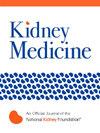Navigating Health Care in Crises: Health Literacy and Treatment Adherence Among Hemodialysis Patients in Lebanon
IF 3.4
Q1 UROLOGY & NEPHROLOGY
引用次数: 0
Abstract
Rationale & Objective
Chronic kidney disease is projected to become the fifth most prevalent chronic condition globally by 2040, with a current prevalence of 10%-15%. This study aimed to assess treatment adherence in relation to health literacy (HL) and digital healthy diet literacy (DDL) levels of patients receiving hemodialysis in Lebanon.
Study Design
A multicenter, cross-sectional study was conducted during 2021-2023.
Setting & Participants
It included patients in 18 dialysis centers based on nonprobability sampling. Patients were eligible if they were aged 18+ years and Arabic speakers. Severe illness, dementia, and confusion were exclusion criteria.
Exposure(s)
Sociodemographic factors (marital status, education, governorate, employment, financial means, and fear of coronavirus disease 2019 [COVID-19]) were assessed as predictors of adherence and HL.
Outcomes
The primary outcomes were HL scores (Health Literacy Scale- Short Form 12), DDL scores (Digital Healthy Diet Literacy Scale), and adherence to treatment scores (treatment adherence questionnaire).
Analytical Approach
Bivariate analysis identified associations between patient characteristics and scores on scales. Simple linear regression was used to evaluate the relationship between scores and independent variables.
Results
Participants (N = 699, 64.5% male patients) showed below-average HL levels (18.96 ± 11.79) and DDL (15.95 ± 14.58), and moderate adherence behavior (995.82 ± 178.99). Single patients and those with higher educational and employment statuses had higher levels of HL. Regional disparities were observed. Individuals who did not experience financial difficulty in covering their treatment cost, and those who had less fear from COVID-19, showed higher DDL scores. Single individuals displayed lower treatment adherence.
Limitations
This study is limited by its cross-sectional design, and by contextual factors that affected patient attendance and researcher access to hemodialysis centers, along with overrepresentation of private facilities.
Conclusions
There is a need for educational programs and targeted interventions to enhance health literacy and adherence in this patient population, especially among those with lower education, financial instability, and higher fear of COVID-19.
Plain-Language Summary
The study sought to determine whether patients receiving hemodialysis in Lebanon have sufficient health literacy, in other words, a capacity to obtain, read, and understand health information in such a way to make informed health decisions and follow treatment instructions. The study found that the majority of patients receiving hemodialysis had difficulties adhering to their treatment. Those with a job and financial stability demonstrated stronger adherence behavior and health literacy. These findings emphasize the need for educational programs aimed at strengthening patients’ self-management skills and improve their health outcomes regardless of the contextual challenges faced.
在危机中导航卫生保健:黎巴嫩血液透析患者的卫生素养和治疗依从性
理由和目的预计到2040年,慢性肾病将成为全球第五大最常见的慢性疾病,目前的患病率为10%-15%。本研究旨在评估黎巴嫩接受血液透析患者的健康素养(HL)和数字健康饮食素养(DDL)水平与治疗依从性的关系。研究设计在2021-2023年间进行了一项多中心、横断面研究。研究对象包括18个透析中心的非概率抽样患者。如果患者年龄在18岁以上并且说阿拉伯语,则符合条件。严重疾病、痴呆和精神错乱是排除标准。社会人口因素(婚姻状况、教育程度、所在省份、就业、经济状况和对2019冠状病毒病[COVID-19]的恐惧)被评估为依从性和HL的预测因素。主要结果为HL评分(健康素养量表-简表12)、DDL评分(数字健康饮食素养量表)和治疗依从性评分(治疗依从性问卷)。分析方法:双变量分析确定了患者特征与量表得分之间的关联。采用简单线性回归评价得分与自变量之间的关系。结果699例患者(男性64.5%)HL水平(18.96±11.79)和DDL(15.95±14.58)均低于平均水平,依从性中等(995.82±178.99)。单身患者和学历、就业状况较高的患者HL水平较高。观察到地区差异。那些在支付治疗费用方面没有经济困难的人,以及那些对COVID-19不那么恐惧的人,DDL得分更高。单个个体表现出较低的治疗依从性。本研究受限于其横断面设计,以及影响患者出诊和研究人员进入血液透析中心的环境因素,以及私人设施的过度代表性。结论有必要开展教育项目和有针对性的干预措施,以提高这一患者群体的健康素养和依从性,特别是在受教育程度较低、经济不稳定和对COVID-19的高度恐惧的人群中。该研究旨在确定黎巴嫩接受血液透析的患者是否具有足够的健康素养,换句话说,是否有能力以这种方式获取、阅读和理解健康信息,从而做出明智的健康决定并遵循治疗指示。研究发现,大多数接受血液透析的患者在坚持治疗方面存在困难。那些有工作和经济稳定的人表现出更强的坚持行为和健康素养。这些发现强调了教育项目的必要性,旨在加强患者的自我管理技能,改善他们的健康结果,而不管所面临的环境挑战。
本文章由计算机程序翻译,如有差异,请以英文原文为准。
求助全文
约1分钟内获得全文
求助全文

 求助内容:
求助内容: 应助结果提醒方式:
应助结果提醒方式:


